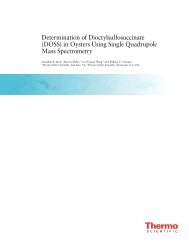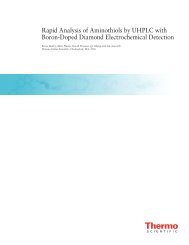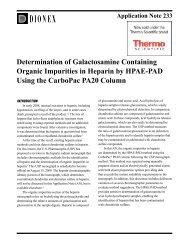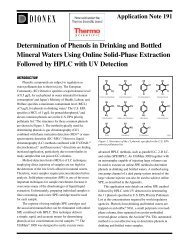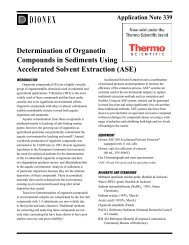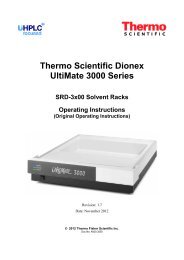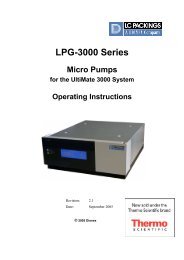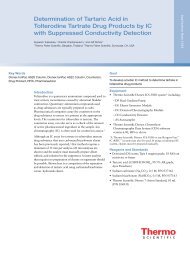Rapid Method for the Estimation of Total Free ... - Dionex
Rapid Method for the Estimation of Total Free ... - Dionex
Rapid Method for the Estimation of Total Free ... - Dionex
Create successful ePaper yourself
Turn your PDF publications into a flip-book with our unique Google optimized e-Paper software.
2 Equipment<br />
• <strong>Dionex</strong> ICS-3000 system consisting <strong>of</strong>:<br />
– DP or SP Gradient or Isocratic Pump, with vacuum<br />
degas option<br />
– DC Detector Compartment with 6-port high-pressure<br />
inject valve, single or dual zone temperature control<br />
– Electrochemical Detector with Carbohydrate Certified<br />
(Au) PTEF Disposable Electrodes (P/N 066480,<br />
package <strong>of</strong> six), or conventional gold working<br />
electrode (P/N 079850)<br />
– Combination pH/Ag/AgCl reference electrode<br />
(P/N 061879)<br />
– Thermo Scientific <strong>Dionex</strong> AS Autosampler<br />
• High carbohydrate concentration accessories,<br />
consisting <strong>of</strong>:<br />
– 0.2 µL injection loop (Stator Face Seal Kit,<br />
P/N 068383), and<br />
– Amperometry cell gasket, 15 mil thickness<br />
(P/N 057364).<br />
– EO1 Eluent Organizer, including one or more<br />
2 L plastic bottles and pressure regulator<br />
• Thermo Scientific <strong>Dionex</strong> Chromeleon Chromatography<br />
Data System<br />
• Helium 4.5 grade, 99.995%, < 5 ppm oxygen; or<br />
Nitrogen 5.0 ultrahigh purity grade, 99.999%, < 1 ppm<br />
oxygen (Praxair)<br />
• Filter unit, 0.2 µm Nylon (Nalgene ® 90 mm Media Plus,<br />
Nalge Nunc International, P/N 164-0020 or equivalent<br />
nylon filter)<br />
• Vacuum pump (Gast P/N DOA-P104-AA or equivalent)<br />
• 0.3 mL Polypropylene injection vials with caps (Vial Kit,<br />
P/N 055428)<br />
Reagents and Standards<br />
Reagents<br />
• Deionized water, 18 MΩ-cm resistance or higher<br />
• 50% sodium hydroxide (w/w; Fisher Scientific,<br />
P/N SS254-500 recommended)<br />
Standards<br />
• D-Glucose, monohydrate (J.T. Baker, Inc., Cat#<br />
1910-01)<br />
• D(–)-Fructose (J.T. Baker, Inc., Cat# M556-05)<br />
• D(+)-Mannose (Sigma-Aldrich, Cat# M-6020)<br />
• D(+)-Galactose (Sigma-Aldrich, Cat# G-0625)<br />
• D(+)-Cellobiose (Sigma-Aldrich, Cat# C-7252)<br />
• D(–)-Arabinose (Sigma-Aldrich, Cat# A-3131)<br />
• D-Xylose (Sigma-Aldrich, Cat# X107-5)<br />
Conditions<br />
<strong>Method</strong><br />
Columns: <strong>Dionex</strong> CarboPac PA1 Analytical, 4 × 250 mm<br />
(P/N 035391)<br />
Flow Rate: 1.0 mL/min<br />
Inj. Volume: 0.2 µL (full loop)<br />
Temperature: 30 °C<br />
Detection: Pulsed amperometry, gold working electrode,<br />
15 mil gasket<br />
pH: 12.5–12.8<br />
Background: 19–36 nC<br />
Typical System<br />
Operating<br />
Backpressure: 1050–1070 psi<br />
<strong>Method</strong>: 200 mM NaOH; isocratic, 10 min run time,<br />
or longer if needed.<br />
Carbohydrate Wave<strong>for</strong>m <strong>for</strong> <strong>the</strong> ED<br />
Time (s) Potential (V) Integration Gain Region* Ramp*<br />
0.00 +0.1 Off On<br />
0.20 +0.1 Begin On On<br />
0.40 +0.1 End Off On<br />
0.41 –2.0 Off On<br />
0.42 –2.0 Off On<br />
0.43 +0.6 Off On<br />
0.44 –0.1 Off On<br />
0.50 –0.1 Off On<br />
Reference electrode in Ag/AgCl mode.<br />
* Additional wave<strong>for</strong>m commands used in <strong>the</strong> <strong>Dionex</strong><br />
ICS-3000; not used in our older systems.<br />
Preparation <strong>of</strong> Solutions and Reagents<br />
Eluents<br />
It is essential to use high-quality water <strong>of</strong> high-resistivity<br />
(18 MΩ-cm) and containing as little dissolved carbon<br />
dioxide as possible. Biological contamination should be<br />
absent. Source water must be obtained using a water<br />
purification system consisting <strong>of</strong> filters manufactured<br />
without electrochemically active surfactants or o<strong>the</strong>r<br />
compounds (<strong>for</strong> example, glycerol). Prior filtration<br />
through 0.2 µm porosity nylon under vacuum is recommended<br />
to remove particulates and reduce dissolved air.<br />
Keep <strong>the</strong> eluent water blanketed under 34–55 kPa<br />
(5–8 psi) <strong>of</strong> helium or high-purity nitrogen at all times to<br />
reduce diffusion <strong>of</strong> atmospheric carbon dioxide and<br />
opportunistic microorganisms. <strong>Dionex</strong> (now part <strong>of</strong><br />
Thermo Scientific) Technical Note 71 10 provides details <strong>for</strong><br />
good eluent preparation practices.




